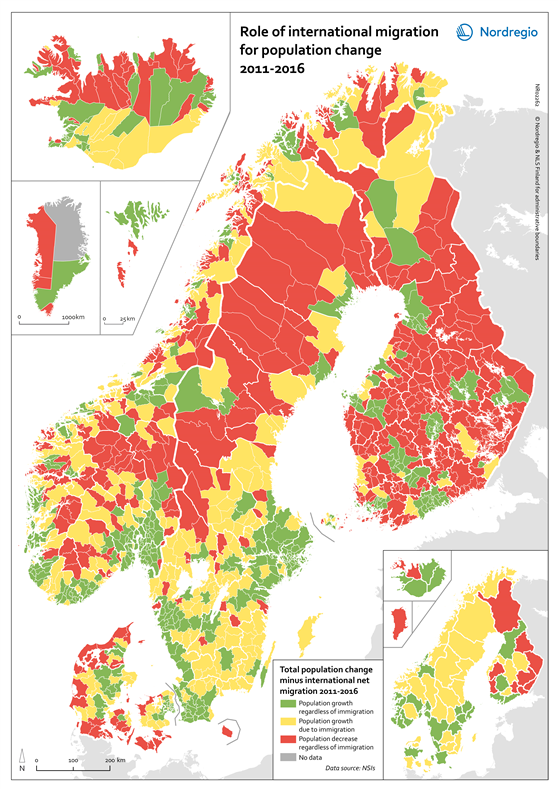This map shows the impact of international migration on population change in the Nordic municipalities between 2011 and 2016. The smaller map shows the impact of international migration on population change in the Nordic regions between 2011 and 2016.

Migration has become the major source of population increase in the Nordic countries. Since 2000, the population of the Nordic countries increased by 2.7 million. Thirty percent of this increase was from natural increase (more births than deaths) and 70% was from net migration (more immigrants then emigrants). This means that most of the population growth is from the immigration of people from either another Nordic country or from outside of the Nordic Region.
The green colour indicates municipalities with a population growth regardless of immigration in 2011-2016. The red colour indicates municipalities with a population decline regardless of immigration in 2011-2016. The yellow colour indicates municipalities with a population growth due to immigration 2011-2016. The grey colour indicates areas with no data available.
Three different types of regions can be distinguished based on the impact of international migration on population change. The first are those where population growth occurred, regardless of international migration (municipalities and regions in green). A second set of municipalities and regions are those where population growth occurred thanks to international migration (municipalities and regions in yellow). A third set of municipalities and regions are those where international migration was insufficient to counter declines from either having more deaths than birth or domestic out-migration, or both, or where net international migration was negative (municipalities and regions in red).
At the regional level, many regions in southern Norway, Sweden, and Finland, the Copenhagen area, and southern Iceland would have grown even without international migration. Most of the northern two-thirds of Norway and Sweden and most areas in Denmark outside the capital region required international migration to have population growth. In Finland, there were a few regions in the southern part of the country where international migration contributed to a population in-crease but in many, international migration was insufficient to counter population declines from other sources. At the municipal level, the map shows that 416 municipalities would have experienced population growth even without immigration, most of these are in or near the capital regions and other large urban centres. A total of 310 municipalities experienced population growth only because of immigration and 485 municipalities experienced a population decrease during the period 2011–2016, even with international migration. The latter were in western Denmark, the more rural municipalities in northern Sweden, much of Finland, and northern Iceland.


